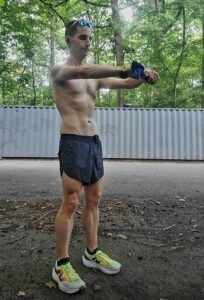I view my 2024 as mostly successful. After all, I hit the ten-year milestone with running and I still have room to improve. I set personal bests in all my races except the road mile. Though with that, I only run the mile once a year and never really train for it. I also placed top ten and earned two age group awards in local races hosted by the New York Road Runners.
Entering this decade, I decided to theme each year. Embodying my 2024 theme of consistency and expansion will yield to my 2025 goal: tackling unfinished business. With both my kids in school full-time, I will train more like I did from 2016-2017, but equipped with more knowledge on how to craft a training program. No, this does not mean blindly running as much mileage per week as possible. I will place emphasis on the dynamic programming of workouts and strength training that compliments distance running. I know my weak points. Intention is key to my development in arriving at peak shape for a goal race. Simply, I will take the next logical step week by week while not changing too many variables.
I know my running body after ten years participating in the sport. I’ve asked the specific questions to learn what I need in order to take my performance to the next level. After all, it took awhile for me to arrive with good and up-to-date information; albeit successful training principles already existed in the decades prior—people only rebrand concepts to pass as the latest fad to improve performance. Further, I did not learn from the trendy influencers on IG, TikTok or some surface level article online. I taught myself through experience while asking the right people. Advice sought from D1 athletes, professional runners who now coach, runners with exercise science degrees, and DPT’s helped me conceptualize my framework of training.
Numerous books were also read to arrive at a deeper understanding of running. A resilient running body handles the demands of achieving the next level in performance. So, I learned useful gym exercises while focusing on drills specific to the running gait. Yes, it pays dividends to know how and what happens to the body during a run. Fighting the body during a warmup might produce a disastrous training session. Knowing how to decrease loading rates while running in an efficient way will not only make running enjoyable, but it will also make tough workouts doable.
In order to take the next step into unlocking a new level of performance, I’m starting with form. Briefly after running the Berlin Marathon, a DPT analyzed my running gait in a lab on the treadmill. Elated, many aspects of gait I studied and worked on with my own running five years ago, looked great. My DPT also saw some inefficient movement, which I could not see, and recommended cues and exercises to optimize efficiency. Combined with knowledge from Jay Dicharry’s two excellent books, Running Rewired and Anatomy for Runners, I have the structure needed to improve running economy while steering clear of injuries.
As far as designing and implementing a training plan, I will take the next logical steps with goals of increasing my volume over time. Plyometrics and strength training will support sustaining the quality of my workouts and distance runs. In return, improving aerobic power, alongside other factors, will help produce personal bests. At the upmost importance, the science of running will not outshine the art form of assembling a training regime that fits my needs. Moreover, the science helps craft a program much like how understanding music theory helps with conceptualizing and creating a composition.
I’m excited to see how 2025 unfolds. No doubt, I’m going to push the limits. The fun and enjoyment lies within the process of exploring the unknown; searching and working on achieving a floating state when running fast, but not hard. Lastly, seeing the framework of training as a whole rather than focusing on a specific detail will make this endeavor worth wild. That aspect is what I’m finally starting to recognize conceptually as I continue to put the pieces of the puzzle together. In regards to this, one cannot paint the whole picture by solely relying on training apps that use AI or social media for guidance.
As I move forward into 2025, I welcome you to follow along with my training on Strava. I wish everyone a healthy and prosperous start to the new year. See you out on the roads.









